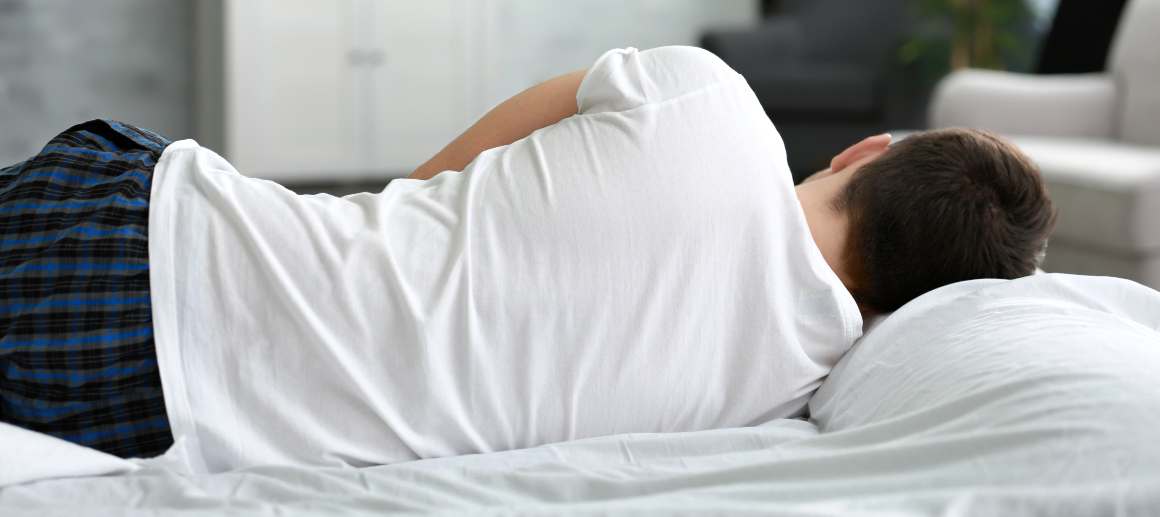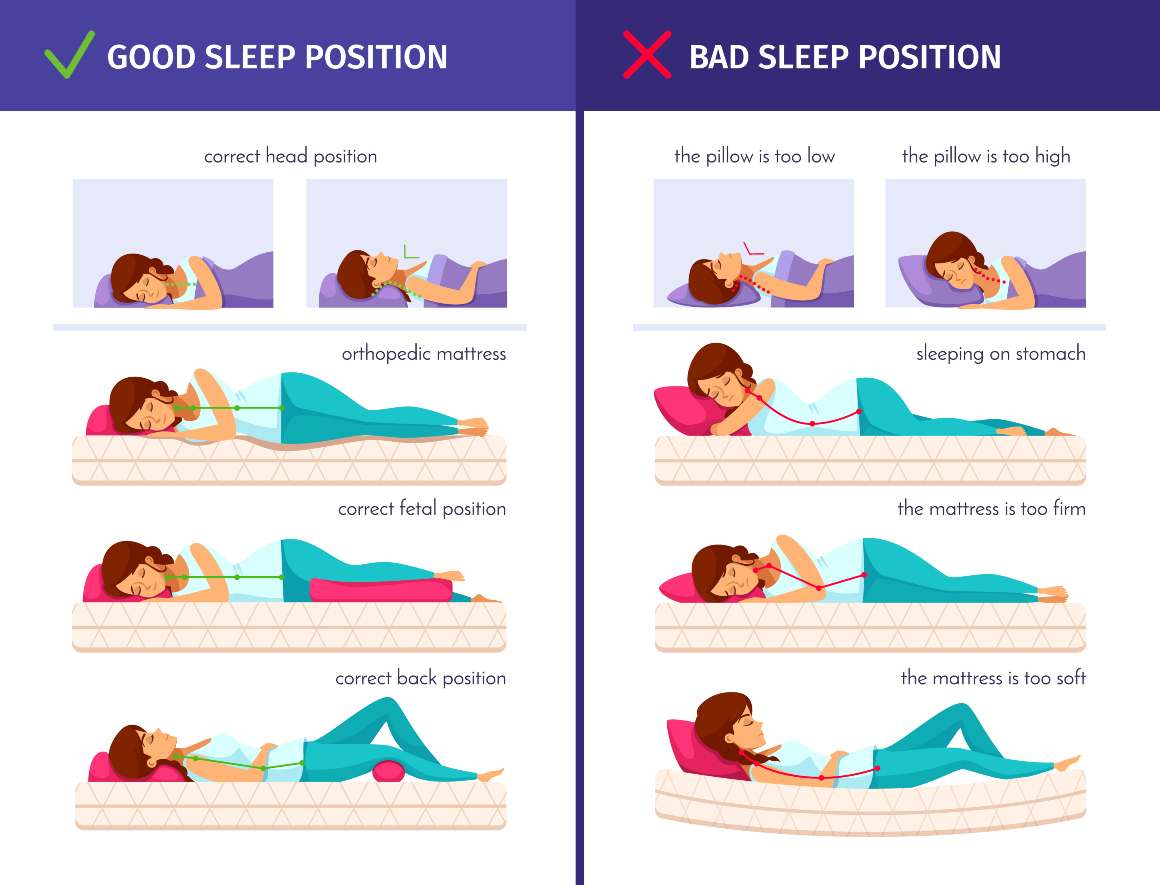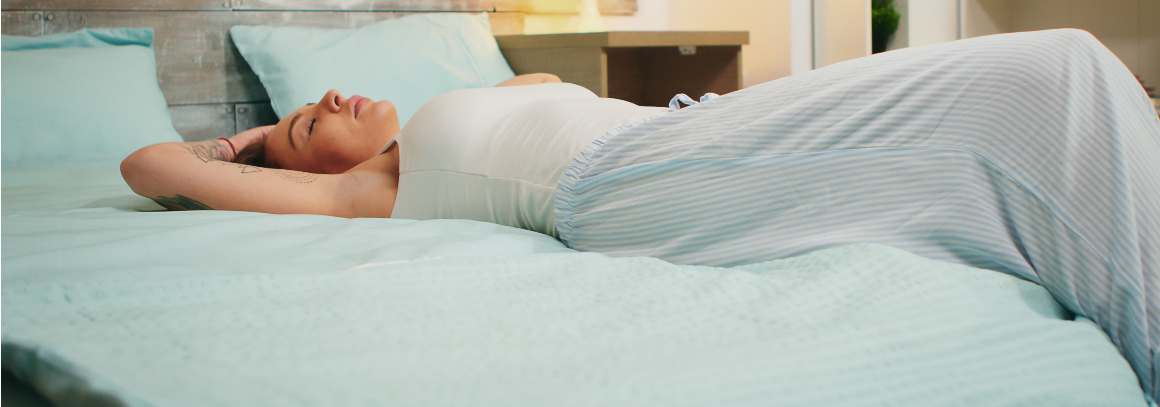How to Sleep on Your Back?
Published:
Learning how to sleep on your back can provide numerous health benefits and improve the overall quality of your rest. As an advanced level professional, I will guide you through the essential aspects of back sleeping and share valuable tips for achieving a comfortable and restful night's sleep in this position.
Contents:
In this blog post, we will explore the various advantages of sleeping on your back, such as reduced tension headaches, relieved sinus congestion, and prevention of facial skin irritation. We'll also discuss proper alignment for back sleepers by choosing the right mattress density and selecting an appropriate pillow.
Furthermore, we'll delve into using pillows strategically for comfortable back sleeping and adjustments specifically designed for Obstructive Sleep Apnea (OSA) sufferers. For pregnant individuals wondering how to sleep on their backs safely, we've got you covered with pregnancy considerations when it comes to this particular sleeping position.
Lastly, our expert advice includes practical tips and techniques that can help train yourself to consistently achieve a good night's rest while learning how to sleep on your back effectively.

The Benefits of Sleeping on Your Back
Sleeping on one's back is thought to be the most advantageous slumbering position, due to its many health advantages, like reducing tension headaches, alleviating sinus congestion and avoiding facial creases or wrinkles. However, finding a comfortable position may not come naturally for everyone. In this section, we will discuss some of the key advantages associated with back sleeping and provide tips for achieving optimal comfort.
Reduced Tension Headaches
One significant benefit of sleeping on your back is that it can help reduce tension headaches. When you sleep in other positions like side or stomach sleeping, there's a higher chance that your neck muscles become strained or misaligned throughout the night. This strain can lead to tension headaches, which are characterized by dull pain around the head or behind the eyes. By maintaining proper alignment while lying flat on your back during slumber hours ensures minimal muscle strain in both neck and shoulders, thus reducing the chances of developing these discomforts.
Relieved Sinus Congestion
If you suffer from sinus congestion or allergies regularly, then switching over onto your back might be just what the doctor ordered. Lying supine allows gravity to work its magic, pulling mucus away from nasal passages, thereby alleviating pressure build-up and leading to better breathing ability and overall improved quality of restorative snooze time.
Prevention of Facial Skin Irritation
- Avoiding pillow-induced wrinkles: Sleeping face-down increases contact between delicate facial tissues against rough fabrics, causing unwanted lines and folds to form overnight. However, when positioned properly atop a cushion surface, less friction occurs, resulting in fewer visible signs of aging upon waking up each morning.
- Reduced acne breakouts: Another advantage back sleepers enjoy is a lower risk of acne breakouts. This is because there's less opportunity for dirt, oil, and bacteria to accumulate on your face when it isn't pressed against a pillow all night long.
- Better skincare product absorption: Finally, if you're someone who invests time and effort into a nightly routine of applying serums, creams, and lotions, then consider switching positions so these products have the optimal chance to absorb effectively without being rubbed off onto bedding materials.
In conclusion, sleeping on your back offers numerous health benefits that can lead to better overall well-being. By making the switch from side or stomach sleeping habits towards this more advantageous posture, not only will individuals experience reduced tension headaches and relieved sinus congestion, but also prevention of facial skin irritation such as wrinkles and acne breakouts, and improved absorption of skincare treatments applied before bedtime each evening.

Proper Alignment for Back Sleepers
To train yourself to sleep on your back properly and comfortably, focus on alignment by choosing a mattress with the proper amount of density. A firm mattress and a pillow that keeps your body in proper alignment while adding the right amount of support are essential. This section will discuss selecting an appropriate mattress density and finding the perfect pillow.
Choosing the Right Mattress Density
The first step towards achieving comfortable back sleeping is selecting a suitable mattress. A medium-firm to firm mattress is ideal for back sleepers as it provides adequate support without causing discomfort or pressure points. When shopping for mattresses, consider factors such as:
- Your weight: Heavier individuals may require firmer mattresses to maintain proper spinal alignment during sleep.
- Type of material: Memory foam, latex, or hybrid mattresses can offer varying levels of support and contouring capabilities tailored to individual preferences.
- Budget: Invest in a high-quality mattress within your budget range that meets your specific needs.
Selecting an Appropriate Pillow
A crucial component of maintaining correct spinal alignment while sleeping on your back is using an appropriate pillow. The right pillow should provide enough support for both head and neck without elevating them too much or allowing them to sink too low into the cushion. Here are some tips when searching for pillows:
- Pillow height (loft): Opt for a pillow with a medium loft, which typically ranges from 3 to 5 inches in height. This will help maintain the natural curve of your neck and prevent strain.
- Pillow material: Memory foam or latex pillows are popular choices for back sleepers as they conform to the shape of your head and neck while providing ample support. Alternatively, adjustable fill pillows made from shredded memory foam or down alternative can be customized to suit individual preferences.
- Pillow firmness: A medium-firm pillow is ideal for most back sleepers since it offers enough support without being too hard on pressure points.
Incorporating these considerations when selecting a mattress and pillow will significantly improve spinal alignment during sleep, leading to more comfortable nights spent resting on your back. Experimenting with different materials and densities may take some time but finding the perfect combination tailored specifically towards you is well worth the effort.
Using Pillows Strategically for Comfortable Back Sleeping
Back sleeping can be difficult if you're accustomed to other postures, but with proper pillow placement and arrangement it is possible to enjoy the advantages of back sleeping while achieving a comfortable night's rest. However, with the right pillow placement and arrangement, you can achieve a comfortable night's sleep while reaping the benefits of back sleeping. In this section, we'll explore how to utilize pillows skillfully in order to attain a more cozy and supportive sleep while lying on your back.
Pillow Placement Under Knees
One effective technique for alleviating lower back discomfort is placing a pillow under your knees. This helps maintain the natural curve of your spine by reducing pressure on the lumbar region. To do this:
- Lie flat on your back with legs extended.
- Place a pillow underneath both knees so that they are slightly elevated.
- Adjust the height of the pillow as needed until it feels comfortable and supportive.
This simple adjustment can help prevent compression or twisting during sleep, which may lead to lower back pain or neck pain if left unaddressed.

Surrounding Yourself With Pillows
If you're an active sleeper who tends to roll over onto their side or stomach inadvertently throughout the night, surrounding yourself with pillows might help keep you in place. By creating physical barriers around your body using pillows, it becomes more difficult for you to change positions unconsciously during sleep. Here's how:
- Lie down on your mattress in a supine position (on your back).
- Place pillows around your body, one under each arm and another along the hips/thighs to form a secure barrier.
- If needed, add additional pillows around you to create a snug barrier that discourages movement during sleep.
To encourage a back-sleeping position, this approach can help your body adjust and become more accustomed to sleeping in such a way.
Additional Pillow Tips for Back Sleepers
In addition to using pillows strategically for support and positioning, it's essential to choose the right type of pillow for optimal comfort. Look for a pillow designed specifically for back sleepers, which typically offers medium-firm support and helps maintain proper neck alignment. Memory foam or latex options are popular choices as they contour closely to the shape of your head and neck while providing adequate support.
Remember that everyone's preferences vary when it comes to pillow firmness, thickness, and material composition. Don't be afraid to experiment with different types until you find one that suits your needs best.
Adjustments for Obstructive Sleep Apnea (OSA) Sufferers
For OSA sufferers, it is essential to modify their sleeping position and environment for a restful sleep. While sleeping on your back is generally recommended, this position may not be suitable for individuals with OSA as it could worsen snoring or exacerbate symptoms related to the condition. In this section, we will discuss how elevating your head using additional pillows and adopting alternative sleep positions can help alleviate OSA symptoms.
Elevating Head Using Additional Pillows
One effective method of reducing OSA symptoms while still maintaining a comfortable back-sleeping position is by elevating your head slightly during sleep. This can be achieved by placing an extra pillow beneath your existing one or investing in a specially designed sleep apnea pillow. Elevating the head helps open up airways, making breathing easier and potentially decreasing instances of snoring and other disruptions caused by obstructed airflow.
Sleeping Positions Suitable for OSA Sufferers
In some cases, simply adjusting the angle at which you sleep may not provide sufficient relief from OSA-related issues. If that's the case, consider trying out different sleeping positions that are more conducive to alleviating these problems:
- Side Sleeping: Lying on either side has been shown to improve airflow in people with mild-to-moderate cases of sleep apnea. The left side is often preferred due to its reduced likelihood of causing heartburn and acid reflux. A pillow designed for side sleepers can help maintain proper spinal alignment while in this position.
- Elevated Side Sleeping: Combining the benefits of both head elevation and side sleeping, this position involves propping up your upper body on a wedge pillow or adjustable bed base to keep airways open. This is particularly helpful for individuals with more severe cases of OSA.
- Tennis Ball Technique: To prevent rolling onto your back during sleep, try attaching a tennis ball to the back of your pajama top using a sock or small pouch. The discomfort caused by lying on the ball will encourage you to remain in a side-sleeping position throughout the night.
In addition to changing your sleeping posture, it's critical to talk with a medical expert about other potential treatments for OSA such as CPAP therapy or life alterations like shedding pounds and stopping smoking. By taking these steps alongside finding an optimal sleep posture, you'll be well on your way toward achieving better quality rest despite living with obstructive sleep apnea.

Tips and Techniques for Training Yourself to Sleep on Your Back
Sleeping on your back can be challenging, especially if you're used to sleeping in other positions. However, with the right techniques and adjustments, you can train yourself to sleep comfortably on your back. Here are some tips that will help make this transition smoother:
Stacked Pillow Technique
One effective method is using the stacked pillow technique. Place two flat pillows beneath your legs while lying down on your back. This helps elevate your legs slightly, reducing pressure on the lower spine and promoting better blood circulation throughout the body.
Arm Positioning
Your arm positioning plays a crucial role in ensuring comfortable back sleeping. Spread your arms wide without letting them rest against the sides of your body or cross over each other. Experiment with different arm placements until you find one that feels most natural for you.
Maintaining Neutral Neck Alignment
To prevent neck pain or discomfort when sleeping on your back, it's essential to maintain a neutral neck alignment by choosing an appropriate pillow height and firmness level. A pillow designed specifically for back sleepers should support both head and neck while keeping them aligned with the spine.
Create a Comfortable Sleeping Environment
- Avoid caffeine before bedtime: Caffeine consumption close to bedtime can interfere with falling asleep easily; therefore, avoid consuming caffeinated beverages at least four hours before going to bed.
- Establish a bedtime routine: A consistent bedtime routine can signal your body that it's time to sleep. Consider incorporating activities such as reading, meditation, or gentle stretching into your nightly ritual.
- Maintain an optimal room temperature: Ensure that the room temperature is comfortable for sleeping, typically between 60-67°F (15-19°C).
Be Patient and Persistent
Becoming accustomed to sleeping on your back may take some time and practice. It is important to remain calm and not become disheartened when transitioning into back sleeping. If you find yourself waking up in a different position throughout the night, gently reposition yourself onto your back without becoming frustrated or discouraged.
Incorporating these tips and techniques will help train you to sleep comfortably on your back while enjoying its numerous health benefits. Remember that consistency is key; stick with these practices until they become second nature for better quality slumber each night.
FAQs in Relation to How to Sleep on Your Back
How to Teach Yourself to Sleep on Your Back
If you want to learn how to sleep on your back, start by selecting a comfortable mattress and pillow. Use the stacked pillow technique for support, position your arms comfortably at your sides or resting on your stomach, and maintain neutral neck alignment. Surrounding yourself with pillows can also help prevent rolling onto your side during sleep.
What Is the Healthiest Way to Sleep on Your Back?
The healthiest way to sleep on your back involves proper spinal alignment and comfort. Choose an appropriate mattress density and supportive pillow that keeps the neck in a neutral position. Place a pillow under your knees for additional support, ensuring even weight distribution across pressure points while maintaining natural spine curvature.
How to Safely Sleep on Your Back
Safely sleeping on your back requires correct body positioning and using pillows strategically for support. Ensure you have a suitable mattress density, use an appropriate headrest keeping your neck aligned neutrally, place another cushion beneath your knees for lumbar relief, elevate your head if needed (for obstructive sleep apnea sufferers), and surround yourself with cushions preventing unwanted turning during slumber.
What Is the Healthiest Sleep Position?
The healthiest sleep position varies depending upon individual needs; however, generally speaking, sleeping on one's side (particularly left) has numerous benefits such as improved digestion and circulation while reducing snoring and acid reflux risks. Back sleeping is also considered healthy when practiced correctly with proper alignment and adequate support.








